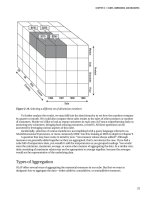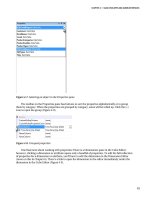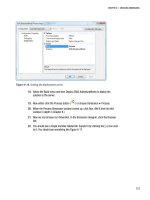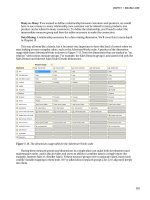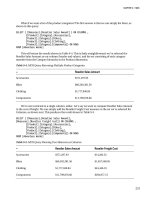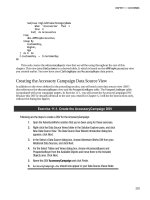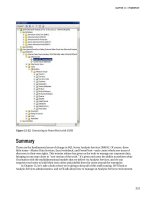Tài liệu Pro SQL Server 2008 Analysis Services- P11 ppt
Bạn đang xem bản rút gọn của tài liệu. Xem và tải ngay bản đầy đủ của tài liệu tại đây (384.97 KB, 11 trang )
INDEX
451
cube with dimensions and, 29
CurrentMember function, 235, 245
custom member formulas, BI, 256
date dimension, 29
default members, 226
DefaultMember property, 156
Dimension Data tab, roles, 352
finding previous or next member, 236
leaf members, 221
MDX notation, 222
parent members, 221
PrevMember function, 245
RootMemberIf property, 158
selecting from dimensions, 221
selecting members of dimensions on cube,
30, 31
tuples, MDX, 224
using member key to select member, 222
using member names for annotations, 222
Members function, 234
Membership tab, roles, 350
MembersWithData property, 157
MembersWithDataCaption property, 158
metadata
attributes, dimensions, 21
cube and measure group metadata locations,
55
Metadata tab, Cube Designer, 262
Calculations page, 187
creating calculated measure, 190
methods
deployment methods, databases, 198
Microsoft Clustering algorithm, 276
Microsoft Data Mining Extensions see DMX
Microsoft Decision Trees algorithm, 277
Microsoft Management Console (MMC) snap-in
OLAP Services, 8
Microsoft Naïve Bayes algorithm, 276
Microsoft Office SharePoint Server see MOSS
mining see data mining
Mining Accuracy Chart view
Data Mining Model Designer, 289, 297–299
mining algorithms see data mining algorithms
Mining Legend
exploring decision tree, 294
Mining Model Prediction view, 289, 299–303
Mining Model Viewer view, 289, 292–297
exploring decision tree, 292–295
using Dependency Network, 296–297
using drill-through to view training cases,
295–296
Mining Models view, 289, 291–292
Mining Structure view, 289, 290–291
mining structures, SSAS, 65
Mining Structures folder, 282
MiningModel objects, SSAS, 51
MiningStructure collection, SSAS, 51
mirroring, SSAS databases, 202–204
modes, dimensions
ProcessingMode, 140
specifying storage modes, 142–148
StorageMode property, 141
MOLAP (multidimensional OLAP), 39, 54
data sources, SSAS, 61
scheduling OLAP maintenance, 215
storage, dimensions, 141
using partitions, 356
MOSS (Microsoft Office SharePoint Server) 2007,
420–423
dashboard, 420, 421
Excel Services, 421, 423
InfoPath Forms Server, 420
KPI lists, 420, 421–423
moving averages calculation, 253
MSAS 2008: Xyz counter groups, 338
msmdsrv.exe, 52
changing Config.ini file location, 54
multidimensional analysis
history of OLAP, 7
multidimensional data, 3
multidimensional expressions see MDX
multidimensional OLAP see MOLAP
multisnowflake schema, 120
N
Naïve Bayes algorithm, 276
Naïve Bayes mining model
Accessory Buyers campaign, 305
named calculations
creating, 110–112
DSV, 110–112
named queries, 62
creating, 113
DSV, 112–116
named query designer, 112, 113
named sets, 251, 262
dynamic named sets, 262
static named sets, 262
NamingTemplate property, 158
INDEX
452
natural hierarchies
attribute relationships, dimensions, 151
navigator
using DSV table navigator, 106
New Calculated Member, Cube menu, 186
New Job Step dialog, 217
New Partition Wizard, 358
New Project dialog, 83, 84
creating data sources, 102
New Project wizard, BIDS, 8
Node_Xyz columns
viewing Accessory Buyers mining model,
307
nonadditive measure, aggregations, 32, 183
None measure, aggregations, 183
Non-Empty Behavior setting
calculated measures, 261
Nonempty function, MDX, 237–239
notification options, dimension storage
Client Initiated option, 142
Scheduled Polling option, 142
SQL Server option, 141
Notifications tab, storage options
specifying dimension storage modes, 145
O
Object Details pane, 214
Object Explorer pane, 214
scheduling OLAP maintenance, 217
Object list
Impact Analysis dialog, 211
Process dialog, 209
object model, SSAS, 51
OLAP (Online analytical processing)
actions, 34–35, 265–270
aggregation, types of, 31–32
AMO design warnings, 135
applications of, 5–7
axes, 233
configuring storage for, 38–39
cubes, 15–18
data source connections to Excel, 374–378
dimension table, 18
dimensions, 20–27
fact table, 18
history of, 7–8
hybrid OLAP (HOLAP), 39–54
introduction to, 1
MDX, 36–37
measure groups, 184
measures, 27–31, 182, 233
calculated measures, 33–34
multidimensional OLAP (MOLAP), 39, 54
relational OLAP (ROLAP), 39, 54
scheduling maintenance, 215–217
schemas, 18–20
setting up Adventure Works, 434
Solution Explorer, 79–80
SQL Server Analysis Services, 41–65
Time dimension, 159–166
user-friendly interfaces for OLAP solutions,
373–429
Excel 2007, 373–398
MOSS 2007, 420–423
PerformancePoint Server, 423–429
SQL Server Reporting Services, 401–
420
Visio 2007, 399–401
using Excel to analyze OLAP data, 6, 7
writeback, 32–33
XMLA (XML for Analysis), 35
OLAP engines
count measure, 27
hierarchies, 25
time-based analysis, 26
OLAP objects, SSAS, 50
OLAP query language, 6, 219
see also MDX
OLAP Server Formatting section
Connection Properties dialog, Excel, 378
OLAP Services
history of OLAP, 8
one-to-many relationships
attribute relationships, dimensions, 151
Currency dimension, 140
relationship types, 180
Online analytical processing see OLAP
operators
unary operators, BI, 255–256
options
processing, Analysis Services, 335–336
Options tab
pivot tables, Excel 2007, 381, 391
OrderBy property, 156
OrderByAttribute property, 156
ordering
attribute ordering, BI, 257
Organization dimension, 137
Output Path property, 197
INDEX
453
P
panes, BIDS, 76–79
Properties pane, 80–82
Solution Explorer, 79–80
tearing off, 78
UI for docking panes, 78
Parallel processing, Change Settings dialog, 335
ParallelPeriod function, MDX, 247, 248
trend indicators, KPIs, 264
Parent function, MDX, 239
Parent hierarchy, Cube Designer, 190
parent members, 221
parent-child dimensions, 157–159
data members for nonleaf members in,
158
setting Unary Operator on parent attribute,
139
parentheses, MDX, 227, 237
partition folders, AdventureWorks cube, 57–58
partition jobs, 337
partitioned cubes
choosing Standard/Enterprise SSAS, 46
partitions
aggregation design, 361
Analysis Services, 359
defining slice of, 359
New Partition Wizard, 358
reasons for using, 356
Specify Options for Partitions and Roles
screen, 199, 200
specifying partition locations, 204
SSAS performance management, 356–359
Partitions tab, 356, 357
enabling/disabling Excel writeback, 313
path to executable file, SSAS, 52, 53, 54
performance
key performance indicators, 263–265
SQL Server 2008, 65–69
writeback, 68
performance management, SSAS, 352–371
aggregations, 359–367
design, 352–359
scalability, 367–369
SharePoint Server 2010, 369–371
virtualization, 369
Performance Monitor, 337–339
PerformancePoint, 373
PerformancePoint Server (PPS), 423–429
building scorecard in, 425–429
Dashboard Designer, 424, 425
scorecard, 423, 424
period to date calculation, 252
periodic growth calculation, 253
PeriodsToDate function, MDX, 247, 248
persp folder, 57
Perspective collection, SSAS, 51
Perspective Designer, 270, 271
perspectives, 251, 270–272
choosing Standard/Enterprise SSAS, 46
folders for, 57
physical architecture, SSAS, 52–54
changing INI file location, 54
pivot charts, 374, 386–398
adding product categories to, 392
Analyze tab, 388
applying color bar conditional formatting,
397
creating, 387
Design tab, 388
Format tab, 388
grouping products, 394
Layout tab, 388
selecting chart type, 387, 388
PIVOT command, SQL, 220, 221
pivot currency, 258
pivot diagrams, Visio 2007, 399, 400
Pivot Table Services, 8
Pivot Table task pane, 380–381
pivot tables, 1, 374, 379–386
building report, 123
Cell Styles gallery, 383
changing appearance and layout, 382
conditional formatting for values, 383, 384
creating custom groupings, 381
cubes and, 15
dangers of using cell references with, 386
design ribbon, 382
dimensional processing, 2–4
formats, 382
formatting, 383–385
formulas using values from, 385–386
GETPIVOTDATA function, 385
graphical view of data, 386
opening style gallery, 382
Options tab, 381, 391
Pivot Table task pane, 380–381
PivotTable options ribbon, 381
PivotTable tools ribbons, 381–382
PowerPivot pivot table in Excel, 323, 324
renaming, 381
INDEX
454
pivot tables (cont.)
setting options, 317
using Excel writeback, 315–319
using MDX to produce, 232
with multiple slicers, 325
PivotTable design ribbon, 382
PivotTable options ribbon, 381
PivotTable Style Options section, 382
PivotTable Styles gallery, 382
polling
Scheduled Polling option, notifications,
142
PowerPivot, 311
connecting with SSMS, 330, 331
entity relationship designer, 323
Excel add-in, 320
Excel writeback, 313–320
from Excel, 320–326
importing tables from SQL Server, 322, 323
Master Data Services, 311–313
pivot table in Excel, 323, 324
pivot table with multiple slicers, 325
support in SQL Server 2008 R2, 311–320
with SharePoint Server 2010, 326–331
PowerPivot Designer, 321, 322
creating relationships, 323
PowerPivot for SharePoint see VertiPaq mode
PowerPivot Gallery, 326, 327
PowerPivot management dashboard
SharePoint Server 2010, 369, 370
Workbook Activity Chart, 370, 371
PowerPivot tab, Excel, 320, 321, 323
PowerPivot workbook
connecting to worksheet, 328, 329
data loaded into Report Builder, 329,
330
in Excel Services, 326, 327, 328
publishing to SharePoint Server, 326
PowerShell, 92–95, 343
for SQL Server, 93–94
getting BIOS data, 93
listing databases using, 93
Windows PowerShell, 92
with SSAS, 94–95
PPS see PerformancePoint Server
prediction column
Clustering algorithm, 277
Decision Tree algorithm, 277
Naïve Bayes algorithm, 276
Prediction Query Builder, 299
PrevMember function, MDX, 245
primary key, table
fact table, 169
self-referential table, 138
priorities
ProcessingPriority, dimensions, 140
ProactiveCaching property
dimensions, 141, 144
measure groups, 185
Process affected objects option
Change Settings dialog, 336
Process checkbox, roles, 351
Process Clear Structure option
Process Cube dialog, 335
Process Cube dialog
AdventureWorks cube, 333–334
Change Settings button, 335
Process Options drop-down list, 334
Process Data option
Process Cube dialog, 210, 335
Process Default option
Process Cube dialog, 210, 334
Process dialog
BIDS, 208, 209
SSMS, 214
Process Dimension window
creating dimensions, 131
specifying dimension storage modes, 147
Process Full option
Process Cube dialog, 210, 334
Process Incremental option
Process Cube dialog, 334
Process Index option
Process Cube dialog, 210, 334
Process method
processing Analysis Services objects from
AMO, 215
Process Mining Structure dialog
Data Mining Model Designer, 290, 291
Process Options drop-down list
Process Cube dialog, 334
Process Progress dialog
processing Analysis Services objects from
BIDS, 212, 213
Process Structure option
Process Cube dialog, 335
Process Update option
Process Cube dialog, 210, 334
processing Analysis Services objects, 204
automating cube processing, 339
availability when processing, 208
from AMO, 215
INDEX
455
from BIDS, 208–214
from SSMS, 214
from XMLA, 215
processing cubes, 333–335
scheduling cube processing, 343
Processing Option property, 197
Processing options tab
Change Settings dialog, 211, 335
processing options, Process dialog, 210
Processing Order section
Change Settings dialog, 335
processing properties, dimensions, 140
processing settings in SSIS, 347
ProcessingMode property
dimensions, 140
measure groups, 185
ProcessingPriority, dimensions, 140
ProClarity, 373, 401
Product dimension, 137
Product Key attribute, 154
Profiler trace, Analysis Services, 337
Profiler, SQL Server, 337
Program Menu Shortcuts option
Adventure Works, 432
project properties see properties, project
project properties dialog, 196, 197
projects
creating, Analysis Services, 82–84
deploying, 195–198
importing database into, 86
New Project dialog, 83, 84
setting up Adventure Works, 431–434
Promotion dimension, 137
specifying storage modes, 142
properties
see also dimension properties
attribute properties, 156
Specify Configuration Properties screen, 200,
201
Properties dialog
Configuration Manager button, 196
Properties pane, 80–82
attribute properties, 156
grouped properties, 81
selecting object in, 81
specifying dimension storage modes, 144
toolbar, 81
properties, project, 195–197
opening project properties, 196
project properties dialog, 196, 197
Proprietary action type, 269
ProspectiveBuyer table
creating Accessory campaign DSV, 281
providers, data sources, 99
Q
Quantitative dimension, 137
queries
see also MDX queries
creating chart in SSRS 2008, 415
named queries, 62
named queries, DSV, 112–116
named query designer, 112
Prediction Query Builder, 299
query-scoped calculated measure, 236
Save Data Mining Query Result dialog, 303
using partitions, 356, 358
Query Binding option, Binding type, 357
query cancellation, SQL Server 2008, 67
Query Designer
building reports with tablix, 406, 407
query language, OLAP, 6
Query timeout, Data Source Designer, 100
QueryLogConnectionString property, 366
QueryLogTableName property, 366
R
RAID
hardware requirements, SSAS, 42
random line, Lift Chart tab
Mining Accuracy Chart view, 298
Rates dimension, 137
recursive data structures, 157
referenced/regular relationships
associating dimensions with measures, 63
relationship types, 180
Related Tables page, 152
relational data models, 97
relational databases, cubes and, 18
relational OLAP see ROLAP
relationship types, 180–181
relationships
associating dimensions with measures, 63
attribute relationships, dimensions, 150–156
creating, PowerPivot Designer, 323
dimensions and measures, 324
flexible relationships, attributes, 151
relating measures and dimensions, 179–181
rigid relationships, attributes, 151

